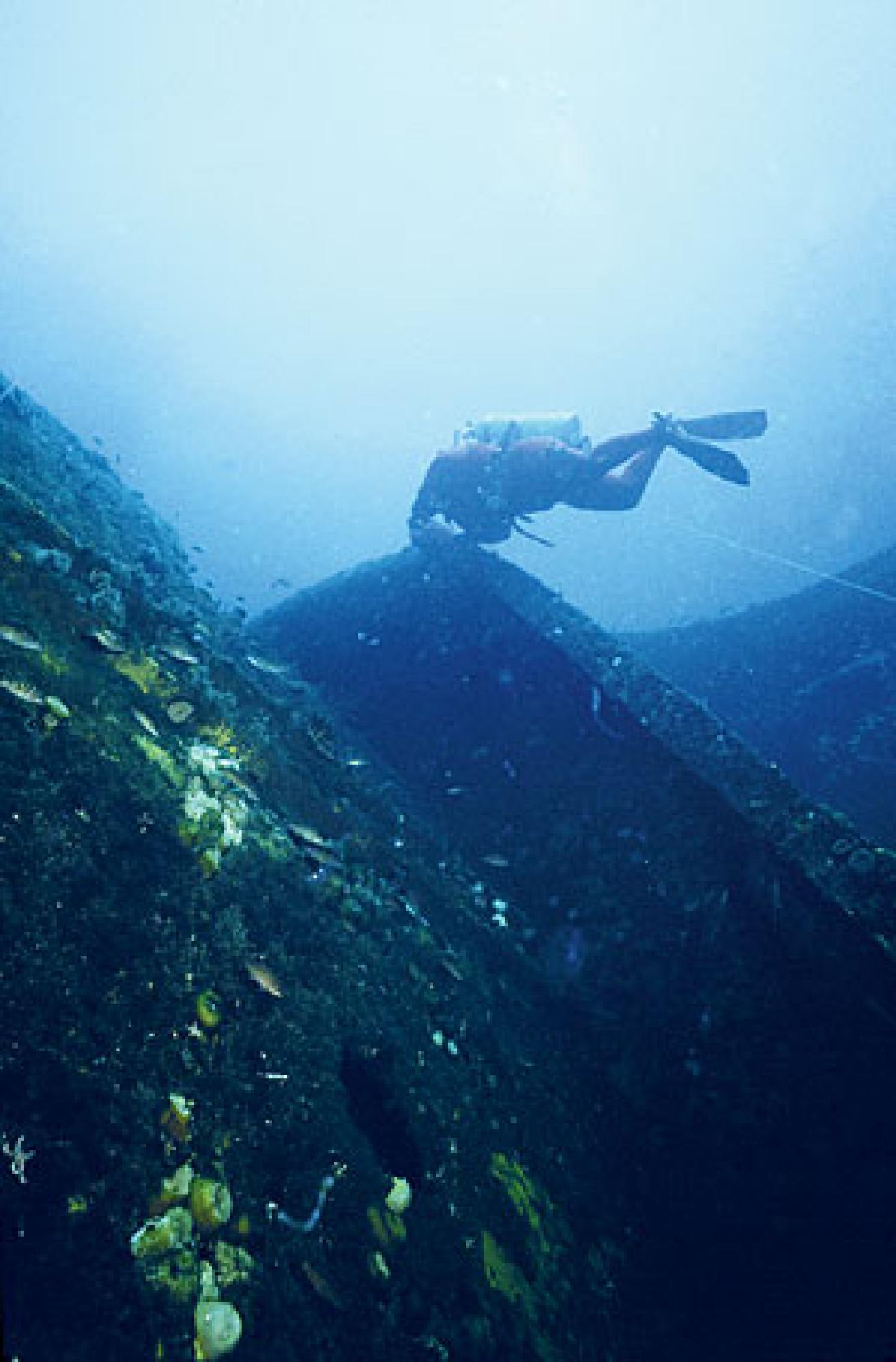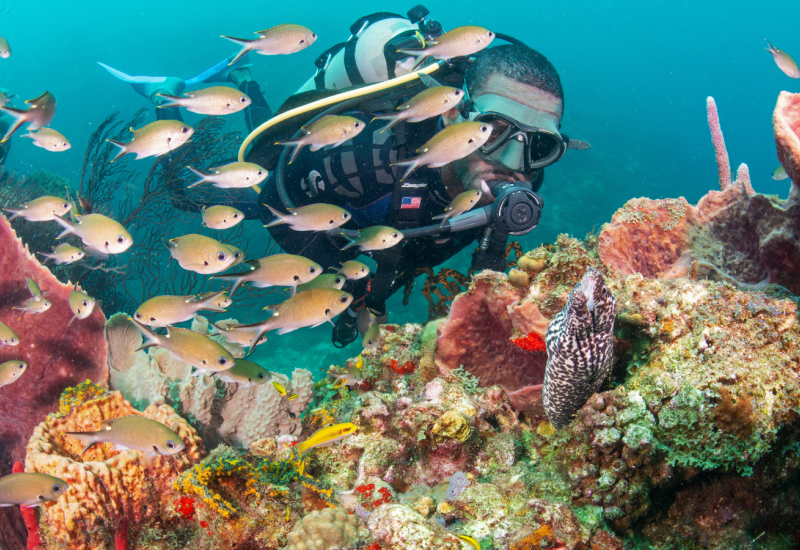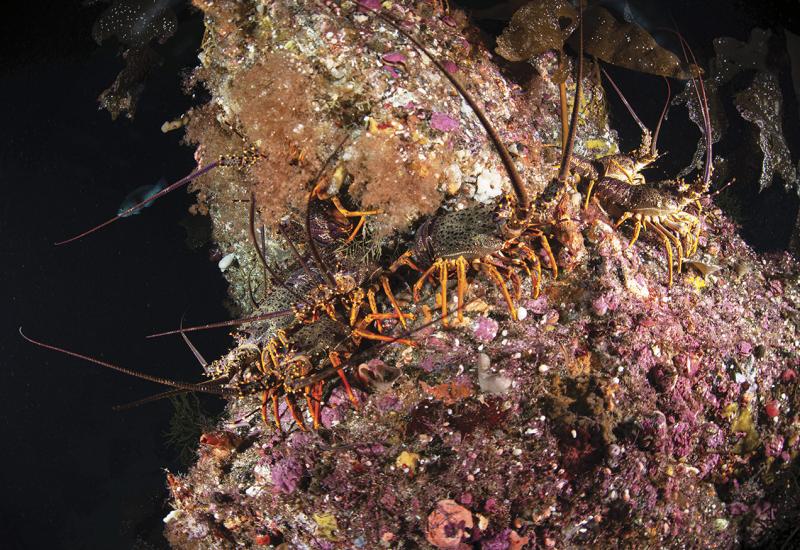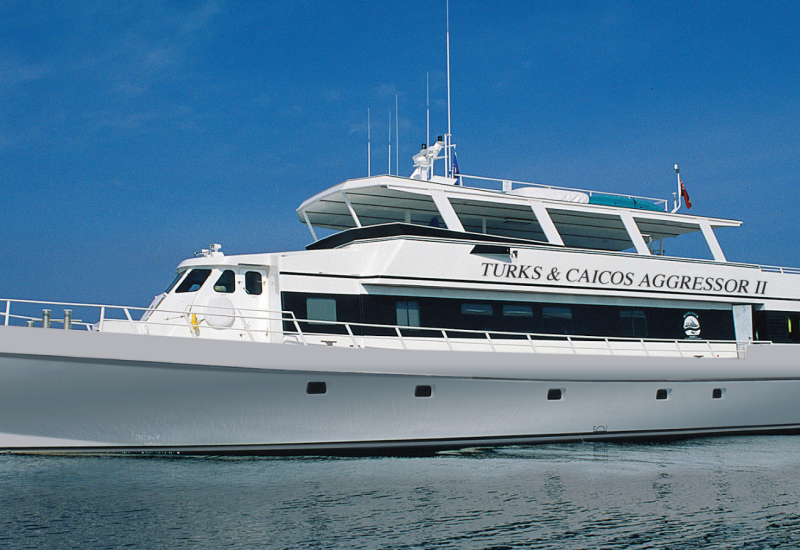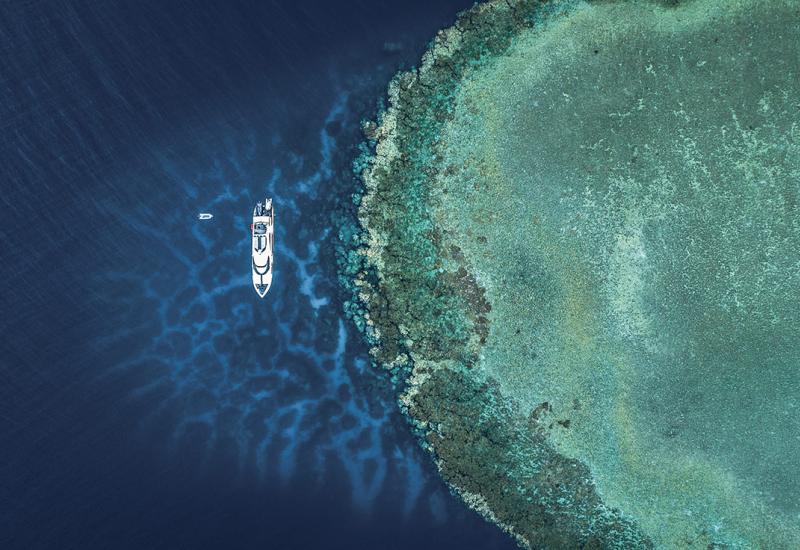Wreck Valley, New York-New Jersey

If you think you can't scuba dive off New York and New Jersey, you are mistaken.
It's a hot summer in the city, but on this day my cousin Brian and I are in refreshingly cool waters, hovering around the bridge of the scuttled, yet perfectly preserved, U.S. Navy transport ship the USN Algol. At 110 feet, Brian ties off the reel and we enter the upper level of the ship's bridge. We navigate around the outside of the superstructure, swimming up and down steps and peeking in rooms. The ship is busy with all kinds of fish life.
We realize it's well worth the three-hour boat ride we took from Brooklyn to get here. And we're almost taking for granted the idyllic conditions — negligible current and 50 feet of visibility. This is, after all, diving in the greater New York City area.
Scuba diving in the Big Apple? "Fuhgeddaboutit!" most outsiders might say. Then they'll likely make a smart-ass quip about cement-shoed mafioso. Or they'll say — correctly — that you can't dive the East River, which spans from the Bronx and Manhattan, between Queens and Brooklyn, or near Ellis Island, home of the iconic Statue of Liberty. Finally, they'll incredulously ask, about New York diving: "Well, what can you see?"
In fact, hundreds of shipwrecks. They dot the waters in a 60-mile zone stretching north to south from the coast of Long Island, through Brooklyn's shores, to the waters of northern New Jersey in an area local divers call Wreck Valley. There are a handful of hardy operators that take divers to sites in this vast area for less than a hundred bucks a trip. New York diving is bit more extreme than in other places, and Advanced Open Water training and 7mm wetsuits or dry suits are musts. Many locals are hard-core technical divers, but that doesn't mean the region's most impressive wrecks--the Algol, the Lizzie D, the Yankee and the Stolt Dagali — are out of reach for recreational divers.
The USN Algol
This 400-foot decommissioned transport ship, near Brick, N.J., is one of Wreck Valley's most popular. It saw action in World War II and the Korean War and was purposely sunk in 1991 as part of the New Jersey Artificial Reef Program.
The ship's superstructure lies perfectly upright in just 70 feet of water, with the main deck at 110. Before sinking, windows and doors were removed, making it very accessible to the beginner wreck explorer. And its size ensures there's always something new for dive veterans to see. Although it has been an artificial reef for just 17 years, the Algol has become home to thriving colonies of mussels and scallops. Further, the cool waters of the Atlantic Ocean nourish an impressive fish population of striped bass, cunners, porgies and dog and blue sharks around the vessel. Most dive boats hold a general-purpose game license that allows divers to collect mussels, scallops and lobsters, so some divers even eschew exploring in favor of loading up their mesh goodie bags with a fresh seafood medley.
The Lizzie D and the Yankee (G&D)
Its 80-foot depth and its proximity to shore (just 8 miles southeast of the Atlantic Beach Inlet in western Nassau County, Long Island) make diving the Lizzie D popular during the summer.
Also known as the "Rum Runner," she sank off of Brooklyn in the 1920s. The Lizzie D was hiding a contraband cargo of prohibition whiskey, and for years after her demise, divers scavenged the bottles. Finding any these days, though, is rare. Still, another popular wreck is the Yankee (G&D), a steamer that sank in 1919 off Fire Island. Although at 110 feet she's much deeper than the Lizzie D, she still has a relatively intact bow and is popular with divers for her numerous lobsters.
The Stolt Dagali
Unlike the Algol, this Norwegian tanker sank in a Thanksgiving Day, 1964, accident, in which she was split in two after colliding with an Israeli luxury liner in heavy fog in New Jersey's Manasquan Inlet. Nineteen sailors died aboard the Stolt Dagali. Today, she sits on her port side at 130 feet, but she's accessible at 60. The hull slopes to one side, producing a "wall" effect oddly reminiscent of those found in parts of the Caribbean because of the orange rust coloring and scores of colorful, frilled anemones and sponges that have latched on. As on the Algol, mussel and scallop colonies thrive on the Stolt Dagali.
We tie off the reel at about 70 feet to a bar at one of her many hull openings. Curious cunners keep nipping at my clumsy fingers. In fact, the small fish follow us throughout the entire dive, swimming circles around us. The Stolt's beauty lies in the massive openings in her hull that allow us to peek into the wreckage without totally exposing ourselves to an enclosed overhead environment. Dropping to about 80 feet, we frog kick through the open, jagged wreck with considerable freedom.
My cousin and I have since turned these dives into an annual summer weekend ritual. And to all outsiders who scoff at New York City diving and make Mafia jokes about our hometown, we've still yet to see the remains of any poor sap from The Godfather who's now "sleeping with the fishes."
Love wreck diving? So do we. For more, visit the Wrecks section of our website.
Dive Info
Dive Conditions: Water temps are in the mid-40s, so diving season is April to October. Visibility can be up to 75 feet, but anything above 20 is considered good. Rough seas sometimes cause operators to cancel dives. Because of fishing lines, dive knives or shears are musts.
Dive Outfitters & Charters: Jeanne II (jeanne-ii.com), Eagle's Nest Wreck Diving, Point Lookout, L.I. (eaglesnestwreckdiving.com), Dina Dee II, Barnegat Light, N.J. (dinadee.com), Captain Mike's Diving, Bronx, N.Y. (captainmikesdiving.com), Pan Aqua Diving, Manhattan (panaqua.com).

If you think you can't scuba dive off New York and New Jersey, you are mistaken.
It's a hot summer in the city, but on this day my cousin Brian and I are in refreshingly cool waters, hovering around the bridge of the scuttled, yet perfectly preserved, U.S. Navy transport ship the USN Algol. At 110 feet, Brian ties off the reel and we enter the upper level of the ship's bridge. We navigate around the outside of the superstructure, swimming up and down steps and peeking in rooms. The ship is busy with all kinds of fish life.
We realize it's well worth the three-hour boat ride we took from Brooklyn to get here. And we're almost taking for granted the idyllic conditions — negligible current and 50 feet of visibility. This is, after all, diving in the greater New York City area.
Scuba diving in the Big Apple? "Fuhgeddaboutit!" most outsiders might say. Then they'll likely make a smart-ass quip about cement-shoed mafioso. Or they'll say — correctly — that you can't dive the East River, which spans from the Bronx and Manhattan, between Queens and Brooklyn, or near Ellis Island, home of the iconic Statue of Liberty. Finally, they'll incredulously ask, about New York diving: "Well, what can you see?"
In fact, hundreds of shipwrecks. They dot the waters in a 60-mile zone stretching north to south from the coast of Long Island, through Brooklyn's shores, to the waters of northern New Jersey in an area local divers call Wreck Valley. There are a handful of hardy operators that take divers to sites in this vast area for less than a hundred bucks a trip. New York diving is bit more extreme than in other places, and Advanced Open Water training and 7mm wetsuits or dry suits are musts. Many locals are hard-core technical divers, but that doesn't mean the region's most impressive wrecks--the Algol, the Lizzie D, the Yankee and the Stolt Dagali — are out of reach for recreational divers.
The USN Algol
This 400-foot decommissioned transport ship, near Brick, N.J., is one of Wreck Valley's most popular. It saw action in World War II and the Korean War and was purposely sunk in 1991 as part of the New Jersey Artificial Reef Program.
The ship's superstructure lies perfectly upright in just 70 feet of water, with the main deck at 110. Before sinking, windows and doors were removed, making it very accessible to the beginner wreck explorer. And its size ensures there's always something new for dive veterans to see. Although it has been an artificial reef for just 17 years, the Algol has become home to thriving colonies of mussels and scallops. Further, the cool waters of the Atlantic Ocean nourish an impressive fish population of striped bass, cunners, porgies and dog and blue sharks around the vessel. Most dive boats hold a general-purpose game license that allows divers to collect mussels, scallops and lobsters, so some divers even eschew exploring in favor of loading up their mesh goodie bags with a fresh seafood medley.
The Lizzie D and the Yankee (G&D)
Its 80-foot depth and its proximity to shore (just 8 miles southeast of the Atlantic Beach Inlet in western Nassau County, Long Island) make diving the Lizzie D popular during the summer.
Also known as the "Rum Runner," she sank off of Brooklyn in the 1920s. The Lizzie D was hiding a contraband cargo of prohibition whiskey, and for years after her demise, divers scavenged the bottles. Finding any these days, though, is rare. Still, another popular wreck is the Yankee (G&D), a steamer that sank in 1919 off Fire Island. Although at 110 feet she's much deeper than the Lizzie D, she still has a relatively intact bow and is popular with divers for her numerous lobsters.
The Stolt Dagali
Unlike the Algol, this Norwegian tanker sank in a Thanksgiving Day, 1964, accident, in which she was split in two after colliding with an Israeli luxury liner in heavy fog in New Jersey's Manasquan Inlet. Nineteen sailors died aboard the Stolt Dagali. Today, she sits on her port side at 130 feet, but she's accessible at 60. The hull slopes to one side, producing a "wall" effect oddly reminiscent of those found in parts of the Caribbean because of the orange rust coloring and scores of colorful, frilled anemones and sponges that have latched on. As on the Algol, mussel and scallop colonies thrive on the Stolt Dagali.
We tie off the reel at about 70 feet to a bar at one of her many hull openings. Curious cunners keep nipping at my clumsy fingers. In fact, the small fish follow us throughout the entire dive, swimming circles around us. The Stolt's beauty lies in the massive openings in her hull that allow us to peek into the wreckage without totally exposing ourselves to an enclosed overhead environment. Dropping to about 80 feet, we frog kick through the open, jagged wreck with considerable freedom.
My cousin and I have since turned these dives into an annual summer weekend ritual. And to all outsiders who scoff at New York City diving and make Mafia jokes about our hometown, we've still yet to see the remains of any poor sap from The Godfather who's now "sleeping with the fishes."
Love wreck diving? So do we. For more, visit the Wrecks section of our website.
Dive Info
Dive Conditions: Water temps are in the mid-40s, so diving season is April to October. Visibility can be up to 75 feet, but anything above 20 is considered good. Rough seas sometimes cause operators to cancel dives. Because of fishing lines, dive knives or shears are musts.
Dive Outfitters & Charters: Jeanne II (jeanne-ii.com), Eagle's Nest Wreck Diving, Point Lookout, L.I. (eaglesnestwreckdiving.com), Dina Dee II, Barnegat Light, N.J. (dinadee.com), Captain Mike's Diving, Bronx, N.Y. (captainmikesdiving.com), Pan Aqua Diving, Manhattan (panaqua.com).

